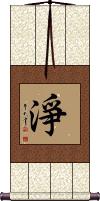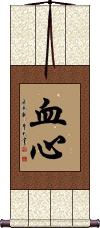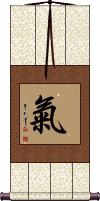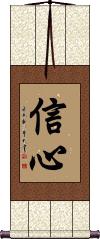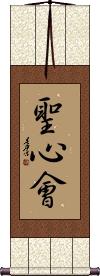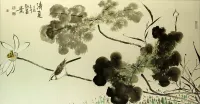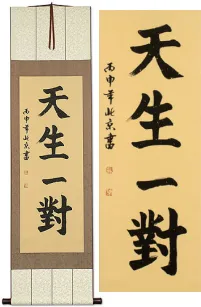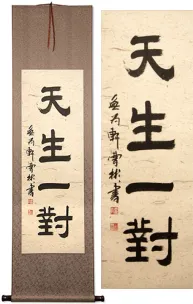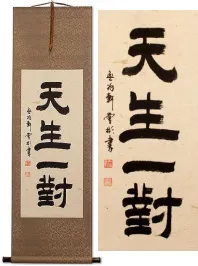Many custom options...
And formats...

Pure Soul in Chinese / Japanese...
Buy a Pure Soul calligraphy wall scroll here!
Personalize your custom “Pure Soul” project by clicking the button next to your favorite “Pure Soul” title below...
Purity
Clean and Pure
淨 is the most simple way to express purity or cleanliness in Chinese, Japanese Kanji, and old Korean Hanja.
As a single character, the concept is broad: This can be a verb (the act of cleaning, purifying, or cleansing) but it can also be the state of being clean, pure, and chaste. In some contexts, it can be a place to clean (like a bathing room for the soul in a Buddhist context). In Japanese, this can be a female given name “Jou” or “jō” (the Japanese equivalent of the English girl's name “Chastity”).
Sincere Heart
When you take 血心 apart, you find the sum is slightly different than the parts. The first character means blood, and the second means heart. It is important to note that for thousands of years, it was believed that your heart was both your soul and your mind in Asian culture. When you add blood to the heart, it is your whole being - the pure and clean dedication of your whole soul.
Most Chinese dictionaries define this as the sincerity of heart or a MEDICAL TERM!!!
Please think carefully before ordering this selection - it was only added as others have used this for coffee cups and other novelties (though perhaps naively).
Life Energy / Spiritual Energy
Chi Energy: Essence of Life / Energy Flow
This 氣 energy flow is a fundamental concept of traditional Asian culture.
氣 is romanized as “Qi” or “Chi” in Chinese, “Gi” in Korean, and “Ki” in Japanese.
Chi is believed to be part of everything that exists, as in “life force” or “spiritual energy.” It is most often translated as “energy flow” or literally as “air” or “breath.” Some people will simply translate this as “spirit,” but you must consider the kind of spirit we're talking about. I think this is weighted more toward energy than spirit.
The character itself is a representation of steam (or breath) rising from rice. To clarify, the character for rice looks like this: ![]()
Steam was apparently seen as visual evidence of the release of “life energy” when this concept was first developed. The Qi / Chi / Ki character is still used in compound words to mean steam or vapor.
The etymology of this character is a bit complicated. It's suggested that the first form of this character from bronze script (about 2500 years ago) looked like these samples: 

However, it was easy to confuse this with the character for the number three. So the rice radical was added by 221 B.C. (the exact time of this change is debated). This first version with the rice radical looks like this: 
The idea of Qi / Chi / Ki is really a philosophical concept. It's often used to refer to the “flow” of metaphysical energy that sustains living beings. Yet there is much debate that has continued for thousands of years as to whether Qi / Chi / Ki is pure energy or consists partially or fully of matter.
You can also see the character for Qi / Chi / Ki in common compound words such as Tai Chi / Tai Qi, Aikido, Reiki, and Qi Gong / Chi Kung.
In the modern Japanese Kanji, the rice radical has been changed into two strokes that form an X.
![]() The original and traditional Chinese form is still understood in Japanese, but we can also offer that modern Kanji form in our custom calligraphy. If you want this Japanese Kanji, please click on the character to the right instead of the “Select and Customize” button above.
The original and traditional Chinese form is still understood in Japanese, but we can also offer that modern Kanji form in our custom calligraphy. If you want this Japanese Kanji, please click on the character to the right instead of the “Select and Customize” button above.
More language notes: This is pronounced like “chee” in Mandarin Chinese, and like “key” in Japanese.
This is also the same way to write this in Korean Hanja where it is Romanized as “gi” and pronounced like “gee” but with a real G-sound, not a J-sound.
Though Vietnamese no longer use Chinese characters in their daily language, this character is still widely known in Vietnam.
See Also: Energy | Life Force | Vitality | Life | Birth | Soul
Confidence / Faithful Heart
信心 is a Chinese, Japanese, and Korean word that means confidence, faith, or belief in somebody or something.
The first character means faith, and the second can mean heart or soul. Therefore, you could say this means “faithful heart” or “faithful soul.”
In Korean especially, this word has a religious connotation.
In the old Japanese Buddhist context, this was a word for citta-prasāda (clear or pure heart-mind).
In modern Japan (when read by non-Buddhists), this word is usually understood as “faith,” “belief,” or “devotion.”
See Also: Self-Confidence
Seishin-Kai / Seishinkai
聖心会 is the Japanese martial arts title “Seishinkai” or “Seishin-Kai.”
It literally means “Sacred Heart Association” or “Pure-Heart Club.”
聖 can mean holy, sacred, saint, sage, virtuous, expert, wise and good, upright, or correct.
心 can mean heart, mind, center, core, spirit, soul, or vitality.
聖心 creates a word meaning sacred heart, or the holy mind (that of Buddha).
会 in Japanese means association, club, meeting, assembly, party, gathering, conference, athletic meet, or society.
Three Treasures of Chinese Medicine
精, 氣, 神 are the characters jing, qi, and shen.
As a set, these three characters are known in English as the treasures of traditional Chinese medicine, the treasures of Qi Gong, or the three treasures of Taoism / Daoism.
Sometimes this set is titled 三寶 (sānbǎo) or “three treasures,” but here, we're writing each treasure out.
Here's how these characters are perceived in this context...
Jing: nutritive essence; refined; perfected; pure
Qi: vitality; energy; force; breath; vigor
Shen: spirit; soul; mind; being
To keep it simple, you can use “essence, vitality, and spirit” to define these.
This in-stock artwork might be what you are looking for, and ships right away...
Gallery Price: $200.00
Your Price: $90.88
Gallery Price: $79.00
Your Price: $43.88
Not the results for pure soul that you were looking for?
Below are some entries from our dictionary that may match your pure soul search...
| Characters If shown, 2nd row is Simp. Chinese |
Pronunciation Romanization |
Simple Dictionary Definition |
精神 see styles |
jīng shen jing1 shen5 ching shen seishin / seshin せいしん |
More info & calligraphy: Spirit(1) mind; spirit; soul; heart; ethos; (2) attitude; mentality; will; intention; (3) spirit (of a matter); essence; fundamental significance; (given name) Seishin Vitality; also the pure and spiritual, the subtle, or recondite. |
十宗 see styles |
shí zōng shi2 zong1 shih tsung jūshū |
The ten schools of Chinese Buddhism: I. The (1) 律宗 Vinaya-discipline, or 南山|; (2) 倶舍 Kośa, Abhidharma, or Reality (Sarvāstivādin) 有宗; (3) 成實宗 Satyasiddhi sect founded on this śāstra by Harivarman; (4) 三論宗 Mādhyamika or 性空宗; (5) 法華宗 Lotus, "Law-flower" or Tiantai 天台宗; (6) 華嚴Huayan or法性 or賢首宗; ( 7) 法相宗 Dharmalakṣana or 慈恩宗 founded on the唯識論 (8) 心宗 Ch'an or Zen, mind-only or intuitive, v. 禪宗 ; (9) 眞言宗 (Jap. Shingon) or esoteric 密宗 ; (10) 蓮宗 Amitābha-lotus or Pure Land (Jap. Jōdo) 淨士宗. The 2nd, 3rd, 4th, and 9th are found in Japan rather than in China, where they have ceased to be of importance. II. The Hua-yen has also ten divisions into ten schools of thought: (1) 我法倶有 the reality of self (or soul) and things, e.g. mind and matter; (2) 法有我無 the reality of things but not of soul; (3) 法無去來 things have neither creation nor destruction; (4) 現通假實 present things are both apparent and real; (5) 俗妄眞實 common or phenomenal ideas are wrong, fundamental reality is the only truth; (6) things are merely names; (7) all things are unreal 空; (8) the bhūtatathatā is not unreal; (9) phenomena and their perception are to be got rid of; (10) the perfect, all-inclusive, and complete teaching of the One Vehicle. III. There are two old Japanese divisions: 大乘律宗, 倶舎宗 , 成實 宗 , 法和宗 , 三論宗 , 天台宗 , 華嚴宗 , 眞言宗 , 小乘律宗 , and 淨土宗 ; the second list adds 禪宗 and omits 大乘律宗. They are the Ritsu, Kusha, Jōjitsu, Hossō, Sanron, Tendai, Kegon, Shingon, (Hīnayāna) Ritsu, and Jōdo; the addition being Zen. |
The following table may be helpful for those studying Chinese or Japanese...
| Title | Characters | Romaji (Romanized Japanese) | Various forms of Romanized Chinese | |
| Purity | 淨 | jou / jo | jìng / jing4 / jing | ching |
| Sincere Heart | 血心 | xuě xīn / xue3 xin1 / xue xin / xuexin | hsüeh hsin / hsüehhsin | |
| Life Energy Spiritual Energy | 氣 气 / 気 | ki | qì / qi4 / qi | ch`i / chi |
| Confidence Faithful Heart | 信心 | shin jin / shinjin | xìn xīn / xin4 xin1 / xin xin / xinxin | hsin hsin / hsinhsin |
| Seishin-Kai Seishinkai | 聖心会 / 聖心會 聖心会 | sei shin kai seishinkai | ||
| Three Treasures of Chinese Medicine | 精氣神 精气神 | jīng qì shén jing1 qi4 shen2 jing qi shen jingqishen | ching ch`i shen chingchishen ching chi shen |
|
| In some entries above you will see that characters have different versions above and below a line. In these cases, the characters above the line are Traditional Chinese, while the ones below are Simplified Chinese. | ||||
Successful Chinese Character and Japanese Kanji calligraphy searches within the last few hours...
